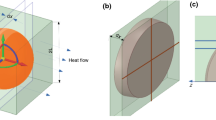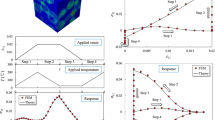Abstract
The combined self-consistent and Mori-Tanaka approach proposed for the evaluation of the effective elastic property of particulate composites is extended to evaluate the effective elastoplastic property of particulate composites. Suppose there are sufficient identical particle inclusions with total volume fraction c in a representative volume element (RVE) of a particulate composite, these inclusions are separated into two groups, with volume fractions (1 − λ−1)c and c/λ over the RVE, respectively. We assume that the first group of inclusions has already been embedded in the original matrix to form a fictitious matrix, and the RVE of the composite consists of the fictitious matrix and the second group of particle inclusions. The property of the fictitious matrix is determined by the conventional self-consistent scheme, while the effective elastoplastic property of the composite is determined by the conventional Mori-Tanaka scheme. Analysis shows that, the conventional Mori-Tanaka scheme and self-consistent scheme can be obtained as the two limit cases of the extended approach as λ = 1 and λ = ∞, respectively. The constitutive behavior of the inclusions in either Group I or Group II is identical, indicating the consistency in the description of the constitutive behavior in the two steps. Furthermore, the effective elastoplastic behavior of some typical particulate composites is analyzed, and the satisfactory agreement between the computational and experimental results demonstrates the validity of the extended approach. The introduced λ can serve reasonably as a parameter, which is related to the actual property of composites and can be identified by experiments, for a more accurate evaluation of the effective elastoplastic property of particulate composites.
Similar content being viewed by others

References
Hershey, A.V., The elasticity of an isotropic aggregate of anisotropic cubic crystals. Journal of Applied Mechanics, 1954, 21(3): 236–240.
Kröner, E., Berechung der elastischen konstanten des vielkristalls aus den konstanten des einkristalls. Zeitschrift für Physik, 1958, 151(4): 504–518.
Budiansky, B., On the elastic moduli of some heterogeneous materials. Journal of the Mechanics and Physics of Solids, 1965, 13(4): 223–227.
Hill, R., A self-consistent mechanics of composite materials. Journal of the Mechanics and Physics of Solids, 1965, 13(4): 213–222.
Mori, T. and Tanaka, K., Average stress in matrix and average elastic energy of materials with misfitting inclusions. Acta Metallurgica, 1973, 21(5): 571–574.
Nemat-Nasser, S. and Hori, M., Micromechanics: Overall Properties of Heterogeneous Materials. North-Holland: Elsevier, 1993.
Hori, M. and Nemat-Nasser, S., Double-inclusion model and overall moduli of multi-phase composites. Mechanics of Materials, 1993, 14(3): 189–206.
Christensen, R.M. and Lo, K.H., Solutions for effective shear properties in three phase space and cylinder model. Journal of the Mechanics and Physics of Solids, 1979, 27(4): 315–330.
Huang, Y., Hu, K.X. and Chandra, A., A generalized self-consistent mechanics method for microcracked solids. Journal of the Mechanics and Physics of Solids, 1994, 42(8): 1273–1291.
Huang, Y., Hu, K.X., Wei, X. and Chandra, A., A generalized self-consistent mechanics method for a composite with multi-phase inclusions. Journal of the Mechanics and Physics of Solids, 1994, 42(3): 491–504.
Hu, G.K. and Weng, G.J., Some reflections on the Mori-Tanaka and Ponte Castañeda-Willis methods with randomly oriented ellipsoidal inclusions. Acta Mechanica, 2000, 140: 31–40.
Li, L.X. and Wang, T.J., A unified approach to predict overall properties of composite materials. Materials Characterization, 2005, 54(1): 49–62.
Kröner, E., Zur plastischen verformung des vielkristalls. Acta Metallurgica, 1961, 9(2): 155–161.
Hill, R., Continuum micro-mechanisms of elastoplastic polycrystals. Journal of the Mechanics and Physics of Solids, 1965, 13(2): 89–101.
Hutchinson, J.W., Bounds and self-consistent estimates for creep of polycrystalline materials. Proceedings of the Royal Society of London, Series A, Mathematical and Physical Sciences, 1976, 348(1652): 101–127.
Pindera, M.J. and Aboudi, J., Micromechanical analysis of yielding of metal matrix composites. International Journal of Plasticity, 1988, 4(3): 195–214.
Berveiller, M. and Zaoui, A., An extension of the self-consistent scheme to plastically flowing polycrystals. Journal of the Mechanics and Physics of Solids, 1979, 26(4): 325–344.
Molinari, A., Canova, G.R. and Ahzi, S., A self consistent approach of the large deformation polycrystal viscoplasticity. Acta Metallurgica, 1987, 35(12): 2983–2994.
Lebensohn, R. and Tome, C., A self-consistent anisotropic approach for the simulation of plastic deformation and texture development of polycrystals: application to zirconium alloys. Acta Metallurgica et Materialia, 1993, 41(9): 2611–2624.
Fotiu, P.A. and Memat-Nassar, S., Overall properties of elastic-viscoplastic periotic composites. International Journal of Plasticity, 1996, 12(2): 163–190.
Mercier, S. and Molinari, A., Homogenization of elastic-viscoplastic heterogeneous materials: self-consistent and Mori-Tanaka schemes. International Journal of Plasticity, 2009, 25(6): 1024–1048.
Zhang, M., Chen, J., Zhu, J. and Chen, J., Experimental evaluation on modulus of equivalent homogeneous ettringite. Acta Mechanica Solida Sinica, 2009, 22(4): 320–327.
Deng, F. and Zheng, Q., Interaction models for effective thermal and electric conductivities of carbon nanotube composites. Acta Mechanica Solida Sinica, 2009, 22(1): 1–17.
Christensen, R.M., A critical evaluation for a class of micro-mechanical models. Journal of the Mechanics and Physics of Solids, 1990, 38(3): 379–404.
Huang, Y., Kwang, K.C., Hu, K.X. and Chandra, A., A unified energy approach to a class of micromechanics models for composite materials. Acta Mechanica Sinica, 1995, 11(1): 59–75.
Peng, X., Hu, N., Zheng, H. and Fukunaga, H., Evaluation of mechanical properties of particulate composites with a self-consistent and Mori-Tanaka approach. Mechanics of Materials, 2009, 41(12): 1288–1297.
Benveniste, Y., A new approach to the application of Mori-Tanaka’s theory in composite materials. Mechanics of Materials, 1987, 6(2): 147–157.
Fan, J. and Peng, X., A physically based constitutive description for nonproportional cyclic plasticity. Journal of Engineering Materials and Technology, 1991, 113(2): 254–262.
Peng, X. and Fan, J., A numerical approach for nonclassical plasticity, computers and structures. Computers & Structures, 1993, 47(2): 313–320.
Peng, X., Long, X. and Fan, J., Micro-macro description for elastoplasticity of materials with lamellar microstructure using anisotropic Eshelby tensor. Mechanics of Advanced Materials and Structures, 2009, 16(7): 542–551.
Kouzeli, M. and Dunand, D.C., Effect of reinforcement connectivity on the elasto-plastic behavior of aluminum composites containing sub-micron alumina particles. Acta Materialia, 2003, 51(20): 6105–6121.
Lloyd, D.J., Particle-reinforced aluminumand magnesiummatrix composite. International Materials Reviews, 1994, 39(1): 1–23.
Derrien, K., Baptiste, D., Guedra-Degeorges, D. and Foulquier, J., Multiscale modeling of the damaged plastic behavior and failure of Al/SiCp composites. International Journal of Plasticity, 1999, 15(6): 667–685.
Nakamura, Y., Yamaguchi, M., Okubo, M. and Matsumoto, T., Effects of particle size on mechanical and impact properties of epoxy resin filled with spherical silica. Jourmal of the applied polymer Science, 1992, 45(7): 1281–1289.
Barai, P. and Weng, G.J., The competition of grain size and porosity in the viscoplastic response of nanocrystalline solids. International Journal of Plasticity, 2008, 24(8): 1380–1410.
Marcadon, V., Herve, E. and Zaoui, A., Micromechanical modeling of packing and size effects in particulate composites. International Journal of Solids and Structures, 2007, 44(25–26): 8213–8228.
Ortiz, M. and Molinari, A., Microstructural thermal stresses in ceramic materials. Journal of the Mechanics and Physics of Solids, 1988, 36(4): 385–400.
Kreher, W., Molinari, A., Residual stresses in polycrystals as influenced by grain shape and texture. Journal of the Mechanics and Physics of Solids, 1993, 41(12): 1955–1977.
Ponte-Castañeda, P., Second-order homogenization estimates for nonlinear composites incorporating field fluctuations: I theory. Journal of the Mechanics and Physics of Solids, 2002, 50(4): 737–757.
Author information
Authors and Affiliations
Corresponding author
Additional information
Project supported by the National Natural Science Foundation of China — NSAF (No. 10976032) and Japan Society for the Promotion of Science (No. L08538).
Rights and permissions
About this article
Cite this article
Peng, X., Hu, N., Long, X. et al. Extension of Combined Self-Consistent and Mori-Tanaka Approach to Evaluation of Elastoplastic Property Of Particulate Composites. Acta Mech. Solida Sin. 26, 71–82 (2013). https://doi.org/10.1016/S0894-9166(13)60008-7
Received:
Revised:
Published:
Issue Date:
DOI: https://doi.org/10.1016/S0894-9166(13)60008-7



